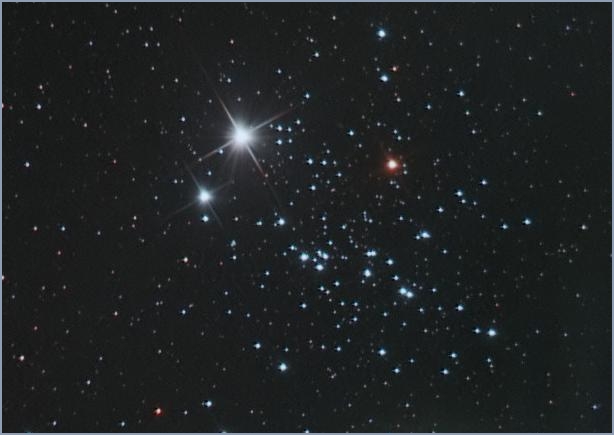Page 2 of 2
Re: APOD: A Zodiacal Skyscape (2012 Feb 23)
Posted: Sat Feb 25, 2012 7:00 pm
by Ann
Chris Peterson wrote:jackfusco wrote:I've actually seen it spelled Pleiades more often than Pleiads. For what it's worth, the spell check on Chrome marks Pleiads incorrect.
The question was with respect to the spelling "Pleides", which is simply incorrect.
The asterism is named for the mythical seven sisters, the Pleiades. Singularly, they are called "Pleiads", so that spelling is correct so long as you are referring to the individual sisters, or to individual stars, and not to the asterism itself.
Now wait a minute... the Pleiades is an
asterism 



I don't think so



Ann
Re: APOD: A Zodiacal Skyscape (2012 Feb 23)
Posted: Sat Feb 25, 2012 7:13 pm
by DavidLeodis
I've noticed that in the copy of the explanation to the APOD given on page 1 it uses 'Pleiades' but, currently at least, it still uses 'Pleides' in the explanation to the APOD as it was issued.

Re: APOD: A Zodiacal Skyscape (2012 Feb 23)
Posted: Sun Feb 26, 2012 12:34 am
by geckzilla
I just refreshed my memory on the definition of an asterism and I don't see why the Pleiades shouldn't qualify.
Edit: Although, further reading on Wikipedia reveals this:
http://en.wikipedia.org/wiki/Asterism_( ... -asterisms
Open clusters are groups of stars that are physically related — gravitationally bound together and moving through the galaxy in the same direction and speed. As these groupings are not human constructs, but real phenomena, they do not count as asterisms. Among the best-known and closest are the Pleiades (M45) and the Hyades in Taurus and the Beehive (M44) in Cancer. (It may be noted that, with the addition of Aldebaran, which is in the same line of sight, the Hyades open cluster forms a V-shaped sectional asterism in Taurus).
Re: APOD: A Zodiacal Skyscape (2012 Feb 23)
Posted: Sun Feb 26, 2012 3:42 am
by Chris Peterson
Ann wrote:Now wait a minute... the Pleiades is an asterism :?: :?: :?: :?:
I don't think so :!: :!: :!:
It absolutely
is an asterism! Many people mistake it for the Little Dipper. An asterism is a recognizable pattern of stars, nothing else. Any open cluster that has that feature (like the Pleiades, Coathanger, or ET) is perfectly reasonably called an asterism.
Re: APOD: A Zodiacal Skyscape (2012 Feb 23)
Posted: Sun Feb 26, 2012 4:01 am
by Beyond
Little Dipper?? I've always called it a scoop. That is, until i got the 'scoop' on it.

Re: APOD: A Zodiacal Skyscape (2012 Feb 23)
Posted: Sun Feb 26, 2012 5:37 am
by TNT
Chris, what's ET? Is it some sort of star cluster?
Re: APOD: A Zodiacal Skyscape (2012 Feb 23)
Posted: Sun Feb 26, 2012 6:01 am
by geckzilla
Chris Peterson wrote:
It absolutely
is an asterism! Many people mistake it for the Little Dipper. An asterism is a recognizable pattern of stars, nothing else. Any open cluster that has that feature (like the Pleiades, Coathanger, or ET) is perfectly reasonably called an asterism.
I think I agree, I mean this quote in particular from Wikipedia makes little sense to me:
As these groupings are not human constructs, but real phenomena, they do not count as asterisms.
What this means is that just because they really are close together means they can't be an asterism? There's a lack of citations on that section of Wikipedia and it seems odd to restrict the labeling of something to just one thing. Can open clusters not also form distinct asterisms? But then again I see this argument taking the same path as the Pluto planet status argument.
Re: APOD: A Zodiacal Skyscape (2012 Feb 23)
Posted: Sun Feb 26, 2012 6:07 am
by bystander
TNT wrote:what's ET? Is it some sort of star cluster?
Wikipedia: NGC 457 wrote:NGC 457 (also known as the Owl Cluster, the ET Cluster, or Caldwell 13) is an open star cluster in the constellation Cassiopeia. It was discovered by William Herschel in 1787. and lies over 7,900 light years away from the Sun. It has an estimated age of 21 million years. The cluster is sometimes referred by amateur astronomers as the Owl Cluster, Kachina Doll Cluster, the ET Cluster (due to its resemblance to the movie character) or the "Skiing Cluster". Two bright stars, magnitude 5 Phi-1 Cassiopeiae and magnitude 7 Phi-2 Cassiopeiae can be imagined as eyes. The cluster features a rich field of about 150 stars of magnitudes 12-15.
Re: APOD: A Zodiacal Skyscape (2012 Feb 23)
Posted: Sun Feb 26, 2012 3:23 pm
by Chris Peterson
geckzilla wrote:I think I agree, I mean this quote in particular from Wikipedia makes little sense to me:
As these groupings are not human constructs, but real phenomena, they do not count as asterisms.
Wikipedia is, on the whole, a good source of information. But it isn't perfect. The statement makes no sense. Taken to its [il]logical extreme, it would suggest that there are groupings of stars that are NOT natural constructs!
AFAIK there is no formal definition of "asterism". Like most words, its definition is simply the product of usage. Astronomers use the term to refer to recognizable star groupings, that's all. Constellations are asterisms. Open clusters are asterisms. Specific groupings
within clusters are asterisms. Groupings inside nebulas (e.g. the Trapezium) are asterisms. Asterisms may be big and obvious to the naked eye, like the Pleiades, or tiny telescopic objects, like M11, the Wild Duck cluster.
